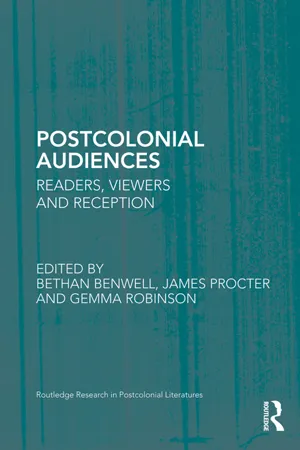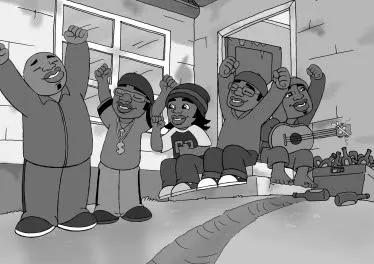![]()
Part I
Real Readers/ Actual Audiences
![]()
1 The Politics of Postcolonial Laughter
The International Reception of the New Zealand Animated Comedy Series bro’Town
Michelle Keown
This chapter takes the New Zealand animated television comedy series bro’Town (written and performed by Polynesian comic actors) as a case study for considering the advantages and limitations of reception theory in analysing audience responses to so-called “ethnic” or “postcolonial” comedy. In particular, the chapter draws upon the distinction reception theorists such as John Guillory have made between “lay” and “professional” interpretations of “texts” (here taken to include media productions as well as literary works). Guillory has described professional “reading” as a “disciplinary” activity, a “kind of work”, governed by “conventions of interpretation”, that “stands back from the experience of pleasure in reading” and is often targeted towards the production of “a public and publishable ‘reading’”. Lay reading, on the other hand, is categorised as a largely solitary leisure activity performed primarily in pursuit of pleasure (Guillory 2000, 31–32). As James Procter points out, however, the distinction between lay and professional reading can be less polarised than Guillory suggests: he discusses this dynamic in relation to book groups, which are “communal rather than solitary affairs”, potentially containing “combinations of both professional and lay readers” and “in certain ways” replicating “the habits of professional reading” (2009, 183). In this chapter I will analyse a range of “professional” and “lay” responses to bro’Town—the former from academics and journalists, and the latter from fans contributing to various Internet discussion forums—in order to suggest that while many bro’Town “lay” readers foreground the show’s appeal as entertainment, some of their responses involve a convergence of putatively separate reading practices associated with “lay” and “professional” constituencies.
In analysing comments posted on the fan websites, I will also evaluate the extent to which “local” and “international” viewers diverge in their responses to the show’s complex comic strategies (given that bro’Town has achieved widespread popularity both within New Zealand and abroad). Comedy often relies heavily upon cultural/racial stereotypes, and as Christiane Schlote notes, critical debates on “ethnic” comedy have commonly centred on the degree to which comedians “use their cultural and national heritages to confront and eventually subvert ethnic and racial stereotypes, or whether their, although satirical, incorporation of these stereotypes into their sketches does not, in fact, lead to their reinforcement” (2005, 180). Such preoccupations characterise many “professional” critical responses to bro’Town, but are also relevant to a comparison of “local” and “international” viewer responses on the bro’Town fan discussion forums. Although the series accommodates a broad spectrum of viewers by blending the conventions of “mainstream” and “ethnic” Anglo-American comedy with the specific strategies of Polynesian comic theatrical traditions, I suggest the “local” knowledge possessed by New Zealand fans often affords them deeper insights into the complexities of the racial politics (and stereotypes) explored in the show, while the responses of overseas viewers appear more in keeping with international marketing strategies that have situated the series within global popular culture while making a feature of its unique status as a “Pacific” production. As I will argue, such strategies can be analysed in terms of Graham Huggan’s theories on the postcolonial “exotic”, given that the international marketing, distribution and reception of the series have subjected it to a “mode of aesthetic perception” which “renders people, objects and places strange even as it domesticates them” (Huggan 2001, 13).
The Pacific “Exotic” and bro’Town’s Exploration of Racial Stereotypes
Significantly, exoticising representations of the Pacific in colonial discourse strongly inflect the racial stereotypes explored in the show. Since the Enlightenment period in particular, the Pacific Islands have been romanticised and exoticised by “Western” explorers, colonial administrators, artists and authors. Although the Pacific encompasses a diverse range of cultures (commonly broken down into the geocultural categories of Polynesia, Melanesia and Micronesia), the Pacific “exotic” has become focused primarily upon the Polynesian “triangle” (from Hawai‘i in the north-east to New Zealand in the south and Easter Island to the east). While the myth of the Pacific as an environmental and sexual “paradise” persists in contemporary media and tourist-industry representations, the formation of substantial Polynesian diasporic communities within Australia, New Zealand and the US since the Second World War has given rise to another, largely negative set of stereotypes representing Pacific immigrants as socio-economic underachievers plagued by domestic violence and alcoholism (Keown 2007, 19 and 2008, 48). The fact that many of these immigrants originate from current or former colonies of the “Western” nations to which they travel has often resulted in a consolidation of these newer stereotypes with earlier colonial representations of the “ignoble” or “uncivilised” sauvage.
bro’Town explores the particular inflections of these stereotypes within Aotearoa New Zealand, revealing both indigenous Māori* and Pākehā resistance to Pacific Island (as well as Asian) immigrants as perceived threats to the unique bicultural relationship that has long shaped understandings of New Zealand “national” identity. Described on the official website as a “proudly suburban, non-PC satire”, the series is set in Morningside, a suburb of Auckland (New Zealand’s largest and most culturally diverse city, often described as “the largest Polynesian city in the world”). It centres on the experiences of five pubescent Polynesian schoolboys, including an indigenous youth known as “Jeff da Maori”, three Samoans (brothers Vale and Valea Pepelo, and friend Sione Tapili), and a boy of mixed Pālagi and Polynesian descent (Rodney McCorkenstein-Taifule, commonly known as “Mack”). The physiognomy and character traits of these youths (depicted in Figure 1.1) are largely based on those of the “Naked Samoans”, four Polynesian comic actors (including Samoan actors Oscar Kightley, David Fane and Mario Gaoa, and Niuean actor Shimpal Lelisi) who created the series (in collaboration with producer Elizabeth Mitchell) and “voice” the characters.
Exploring dominant cultural stereotypes of immigrants with a prevailing wry humour, bro’Town invites comparisons with other “ethnic” or “postcolonial” comedy such as Goodness Gracious Me (a character comedy series created by four British Asian actors), but it is also rooted in Samoan fale aitu (literally, “house of spirits”), a theatrical tradition in which actors perform comic sketches commonly replete with verbal punning, sexual innuendo, social critique, role reversals and transvestism, with male actors often adopting exaggerated female personas (see Sinavaiana-Gabbard 1999 and Keown 2008). Although much of bro’Town’s humour and cultural references are aimed at a New Zealand audience, its considerable success abroad has been attributed to its affinity with North American animated comedy series such as South Park and The Simpsons (Henley 2004; Wichtel 2004; Lustyik and Smith 2010). Like its globalised counterparts, bro’Town features a blend of socio-political satire, postmodernist parody and cameo performances from various local and international celebrities and public figures (from actor Sam Neill and New Zealand Samoan hip hop artist Scribe, to Prince Charles and former New Zealand Prime Minister Helen Clark).
Figure 1.1 bro’Town’s five central characters (from left to right): Mack, Sione, Valea, Vale and Jeff da Maori. Image courtesy of Firehouse Films (c) 2005.
bro’Town first aired in September 2004, with six thirty-minute episodes screened at 8:00 p.m. on Wednesdays, reaching a large, culturally and demographically diverse “primetime” audience, and running to five series in total (ending in 2009). The show was strategically scheduled straight after The Simpsons (on commercial channel TV3) and proved popular with both adult and young viewers: series 1, for example, attracted 33 percent of the total viewing audience during its timeslot, and in 2005 bro’Town was the top rating series for 5–12-year-olds (Lustyik and Smith 2010, 343; Bannister 2008, 7). As media reception theorists (both within and beyond New Zealand) have noted, visibly “different” ethnic minorities living in white-dominated societies are often negatively stereotyped or excluded from representation in mainstream media, and in this context bro’Town is a rare example of a production, featuring and created by Pacific Islanders, that has achieved widespread mainstream success (Kothari, Pearson and Zuberi 2004; Staiger 2005). bro’Town won the “best comedy” category of the TV Guide “Best on the Box”—New Zealand’s largest annual “people’s choice” television audience award—for four years in a row (until 2008), and won again in 2010 following the screening of the final series. It was selected as the theme for the New Zealand village at the 2008 Beijing Olympics, and in 2010 formed the focus of a long-term installation at New Zealand’s national museum, Te Papa.
“Professional” Critical Responses to bro’Town’s Racial Politics
Alongside its considerable popularity, bro’Town has generated critical controversy, largely due to conflicting responses to the show’s engagement with racial stereotypes. Within New Zealand, the channelling of post-war Pacific immigrants (as well as Māori) into low-skilled jobs and depressed housing areas has led to widespread social deprivation, and much of the show’s humour operates by invoking and (often implicitly) satirising dominant cultural stereotypes associated with Māori and Pacific socio-economic “problems” (including unemployment, domestic violence, alcoholism and “broken homes”). As noted earlier, in “professional” critical circles bro’Town’s irreverent comedy has sparked debate about whether the show ultimately reinforces cultural stereotypes even as it lampoons them, given the differences in the “horizon of expectations” (Jauss 1982) among viewers from different ethnic and demographic groups. Samoan academic Melani Anae has argued that bro’Town promotes the stereotype of “the happy-go-lucky funny brown coconut” that Pacific Islanders “fought against in the 70s”, and that Kightley is one of a number of Pacific creative practitioners who “pick the negatives of our cultures and get rich on it by entertaining people” (Spratt 2006, 20). This argument resonates with debates among media reception theorists regarding the burden of representation placed upon ethnic minority creative practitioners (Kothari, Pearson and Zuberi 2004; Schlote 2005; Staiger 2005). As Samoan columnist Tapu Misa points out in a more sympathetic analysis of Kightley’s work:
This is the other side of being a prominent brown playwright, comedian, and entertainer . . . Everything you do is loaded with meaning and consequence. It isn’t enough that you’re funny and entertaining, as well as commercially successful and critically acclaimed. You have to be socially responsible, too. (2006, E1)
Concerns about bro’Town’s engagement with racial stereotypes have also been expressed by Pākehā/Pālagi commentators. In a review of “bro’Town Live on Stage”, a stage documentary about the show performed at the 2008 New Zealand Arts Festival, Melody Nixon expressed reservations about bro’Town’s humour from a “white” point of view, remarking: “As with the TV show I felt a slight dissonance at the mass laughter at racial stereotypes, and wondered if we (we Pakeha, especially) were allowed to be laughing, really” (2008). Another Pākehā critic, Greg Dixon, similarly criticised bro’Town’s putative reliance on “incredibly blunt, incredibly predictable” racial stereotypes (2004).
In defending bro’Town against such assessments, Kightley argues that laughter is an effective way of confronting and critiquing social “flaws”, and that it can also help to ameliorate the bleakness of the lives of Pacific peoples suffering socio-economic deprivation (Spratt 2006, 20). He also reminds critics of the show’s grounding in fale aitu, which customarily serves a mediatory function, serving (like romantic comedy) to resolve “tension or conflict between major characters” (Wichtel 2006; Sinavaiana-Gabbard 1999, 188). The targets of fale aitu comedy—often present at performances, and representing all levels of the social spectrum, from commoner to chief—are expected to take the satire “in the spirit of fun”, and a similar expectation appears to be implicit in bro’Town (Sinavaiana-Gabbard 1999, 186).
One of the key episodes in which this dynamic plays out is “Morningside Story” (series 2), where Vale writes and directs a musical (loosely based on Arthur Laurents’s West Side Story) that projects a utopian social vision in which Morningside’s (and by extension, wider New Zealand’s) different ethnic communities learn how to “get along”. Vale is inspired to write the musical after witness...

